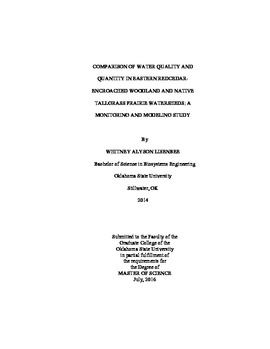| dc.contributor.advisor | Fox, Garey A. | |
| dc.contributor.author | Lisenbee, Whitney Alyson | |
| dc.date.accessioned | 2017-02-22T22:15:32Z | |
| dc.date.available | 2017-02-22T22:15:32Z | |
| dc.date.issued | 2016-07-01 | |
| dc.identifier.uri | https://hdl.handle.net/11244/49106 | |
| dc.description.abstract | The encroachment of Eastern Redcedar (Juniperus virginiana) has become a major concern across the Great Plains region. This species has diminished ecological benefits provided by the grasslands they are replacing. It was suggested that Eastern Redcedar be used as a biofuel feedstock to serve a dual purpose of more biofuel production and restoration of native grasslands. This study compared two tallgrass prairie and two Eastern Redcedar encroached woodland watersheds identified in the Oklahoma State University Cross Timbers Experimental Range (CTER). Surface runoff samples were collected in each watershed to compare total runoff and sediment concentrations between encroached and tallgrass prairie watersheds prior to Eastern Redcedar removal. Measured data showed less runoff in the encroached sites compared to the tallgrass prairie. However, the sediment yield in all watersheds was similar. These data were also compared to uncalibrated Water Erosion Prediction Project (WEPP) simulations to evaluate the model. WEPP simulations were conducted using site-specific soil and slope inputs and a variety of climate inputs to represent wet, dry, long-term, and field site conditions. All site-specific WEPP simulations showed increased runoff and sediment yield in the encroached woodland compared to tallgrass prairie watersheds. Future work including calibration of WEPP using data from CTER will provide more guidance on if default values are sufficient or if field-measured parameters improve model predictions. The soil erodibility parameters were further investigated in WEPP. Currently, WEPP uses empirical equations to determine two major erodibility parameters within the soil input file: the critical shear stress (?c) and the erodibility coefficient (kd). These erodibility parameters were determined mechanistically in the field using the Jet Erosion Test (JET). The JET-derived erodibility parameters were compared to WEPP-predicted values. The WEPP erodibility parameters were directly correlated with the soil texture. However, JET-derived erodibility parameters were significantly different between the two land covers with no relationship observed to soil texture. Uncalibrated WEPP simulations failed to indicate differences in predicted sediment transport between the erodibility parameters likely due to the small range in applied shear. This investigation highlights the need to use in situ testing to determine erodibility of a field site to better incorporate the effects of land cover when predicting hillslope sediment detachment in hydrologic modeling. | |
| dc.format | application/pdf | |
| dc.language | en_US | |
| dc.rights | Copyright is held by the author who has granted the Oklahoma State University Library the non-exclusive right to share this material in its institutional repository. Contact Digital Library Services at lib-dls@okstate.edu or 405-744-9161 for the permission policy on the use, reproduction or distribution of this material. | |
| dc.title | Comparison of Water Quality and Quantity in Eastern Redcedar-encroached Woodland and Native Tallgrass Prairie Watersheds: A Monitoring and Modeling Study | |
| dc.contributor.committeeMember | Storm, Dan | |
| dc.contributor.committeeMember | Zou, Chris | |
| osu.filename | Lisenbee_okstate_0664M_14753.pdf | |
| osu.accesstype | Open Access | |
| dc.description.department | Biosystems & Agricultural Engineering | |
| dc.type.genre | Thesis | |
| dc.type.material | text | |
